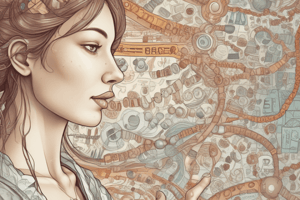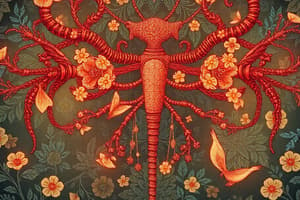Podcast
Questions and Answers
What are the main classifications of hormones based on chemical structure?
What are the main classifications of hormones based on chemical structure?
- Carbohydrate derivatives, Lipids, Nucleic acids
- Amino acid derivatives, Steroids, Proteins/polypeptides (correct)
- Enzymes, Buffers, Acidic substances
- Alcohols, Aldehydes, Ketones
What does ACTH stimulate in the adrenal cortex to secrete?
What does ACTH stimulate in the adrenal cortex to secrete?
glucocorticoids and small amounts of sex hormones
Steroids, thyroid hormones, vitamin D, and retinoids interact with extracellular receptors.
Steroids, thyroid hormones, vitamin D, and retinoids interact with extracellular receptors.
False (B)
Match the hormone with its principal action:
Match the hormone with its principal action:
Which cells in the pancreas produce insulin?
Which cells in the pancreas produce insulin?
Prolactin is principally involved in the development of the female breast and the initiation and maintenance of ______ production shortly after childbirth.
Prolactin is principally involved in the development of the female breast and the initiation and maintenance of ______ production shortly after childbirth.
What are the principal effects of insulin?
What are the principal effects of insulin?
Which genetic defects are associated with diabetes mentioned in the content?
Which genetic defects are associated with diabetes mentioned in the content?
Type 1 Diabetes Mellitus predominantly develops in older adults.
Type 1 Diabetes Mellitus predominantly develops in older adults.
Match the main hormones with their gland:
Match the main hormones with their gland:
Flashcards are hidden until you start studying
Study Notes
Pathophysiology of Endocrine Disorders
Introduction to Endocrine System
- The endocrine system is one of the two major systems for coordination and control of organ function.
- It consists of endocrine glands that secrete chemical messengers called hormones.
- Hormones are defined as chemical signals secreted into the bloodstream that act on distant tissues, usually in a regulatory fashion.
- The primary functions of hormones include:
- Control of reproduction
- General growth and development of the body
- Regulation of electrolyte composition of bodily fluids
- Control of energy metabolism
Classification of Hormones
- Hormones can be classified into three main groups:
- Amino acid derivatives (e.g. epinephrine, norepinephrine, thyroxine)
- Steroids (e.g. cortisol, estrogen, progesterone, testosterone, vitamin D)
- Proteins/Polypeptides (e.g. insulin, glucagon, GH, PTH, TSH, LH, FSH, β-hCG, TRH, vasopressin)
Endocrine Glands
- The major endocrine glands that function primarily to secrete hormones include:
- Pituitary gland
- Produces hormones such as ADH, oxytocin, ACTH, GH, TSH, LH, FSH, prolactin
- Thyroid gland
- Produces hormones such as thyroxine, triiodothyronine, and calcitonin
- Parathyroid gland
- Produces parathyroid hormone
- Adrenal gland
- Produces hormones such as cortisol, aldosterone, epinephrine, and sex steroids
- Pancreas
- Produces hormones such as insulin, glucagon
- Ovaries and testicles
- Produce hormones such as androgens, estrogens, and progesterone
- Pineal gland
- Produces melatonin
- Pituitary gland
- Other endocrine glands and tissues include:
- Heart (produces atrial natriuretic peptide)
- Kidney (produces erythropoietin)
- Liver (produces somatomedin)
- Skin (produces vitamin D3)
- Gastrointestinal tract (produces gastrin, CCK, and VIP)
- Adipose tissue (produces leptin)
- Hypothalamus (produces CRH, TRH, GnRH, dopamine)
Action of Hormones
- Hormones elicit their effects by binding to receptors, which can be:
- Cell-surface membrane receptors (e.g. amino acid derivatives, peptide hormones)
- Intracellular nuclear receptors (e.g. steroids, thyroid hormones, vitamin D)
- Hormones can regulate intracellular metabolic processes through:
- Second messengers (e.g. c-AMP, c-GMP, phospholipase C-Ca2+, tyrosine kinase)
Pituitary Gland
- The pituitary gland is divided into two parts:
- Anterior pituitary (adenohypophysis)
- Posterior pituitary (neurohypophysis)
- Hormones produced by the pituitary gland include:
- GH, TSH, LH, FSH, prolactin, ACTH
Pathophysiology of Endocrine Diseases
- Endocrine diseases can be divided into three major types:
- Hormone excess (hypersecretion)
- Hormone deficiency (hyposecretion)
- Hormone resistance
- Endocrine disorders can be caused by:
- Genetic defects
- Tumors
- Infection
- Infiltrative processes
- Vascular disorders
- Trauma
- Immune-mediated injury
- Metabolic abnormalities
- Drugs
Hormones of the Anterior Pituitary Gland
- Growth Hormone (GH)
- Functions: stimulates cell growth and expansion, antagonizes insulin
- Deficiency: short stature in children
- Excess: gigantism, acromegaly
- Thyroid-Stimulating Hormone (TSH)
- Functions: stimulates thyroid gland to secrete T3 and T4
- Deficiency: hypothyroidism
- Excess: hyperthyroidism
- Adrenocorticotropic Hormone (ACTH)
- Functions: stimulates adrenal cortex to secrete glucocorticoids and sex steroids
- Deficiency: hypocortisolism
- Excess: Cushing's syndrome
- Follicle-Stimulating Hormone (FSH) and Luteinizing Hormone (LH)
- Functions: stimulate development of ovarian follicle and oestrogen production
- Deficiency: amenorrhoea, sterility, loss of sexual potency
- Excess: sexual precocity
- Prolactin
- Functions: stimulates development of breast tissue, lactation
- Deficiency: failure of lactation
- Excess: galactorrhoea, hypogonadism
Hormones of the Posterior Pituitary Gland
- Vasopressin (ADH)
- Functions: stimulates reabsorption of water in kidneys, vasoconstriction
- Deficiency: diabetes insipidus
- Excess: SIADH (syndrome of inappropriate ADH)
- Oxytocin
- Functions: stimulates uterine contraction, milk ejection
- Deficiency: failure of milk ejection
- Excess: none known
Adrenal Gland
- Adrenal Cortex
- Produces glucocorticoids, mineralocorticoids, and sex steroids
- Functions: regulate carbohydrate, protein, and fat metabolism, electrolyte balance
- Disorders: Cushing's syndrome, Addison's disease, Conn's syndrome
- Adrenal Medulla
- Produces epinephrine and norepinephrine
- Functions: stimulates "fight or flight" response
- Disorders: pheochromocytoma
Pancreas
- Produces insulin, glucagon, and somatostatin
- Functions: regulate blood glucose levels
- Disorders: diabetes mellitus, insulinoma
Thyroid Gland
- Produces thyroxine (T4), triiodothyronine (T3), and calcitonin
- Functions: regulate basal metabolic rate, cardiac contractility, and growth
- Disorders: hyperthyroidism, hypothyroidism, thyroiditis
Studying That Suits You
Use AI to generate personalized quizzes and flashcards to suit your learning preferences.




